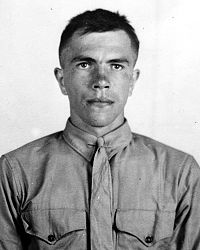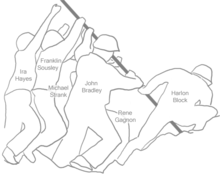- Michael Strank
-
Michael Strank 
Born November 10, 1919
Jarabina, Czechoslovakia (now Slovakia)Died March 1, 1945 (aged 25)
KIA on Iwo JimaPlace of burial Arlington National Cemetery Allegiance United States of America Service/branch United States Marine Corps Years of service 1939-1945 Rank Sergeant Unit 2nd Battalion, 28th Marines Battles/wars World War II
* Battle of Bougainville
* Battle of Iwo JimaAwards Bronze Star
Purple HeartMichael Strank (Rusyn: Mykhal Strenk; Slovak: Michal Strenk) (November 10, 1919 – March 1, 1945) was a Sergeant in the United States Marine Corps during World War II. He was photographed raising the flag atop Mount Suribachi during the Battle of Iwo Jima. The leader of the group in the famous picture was Strank, who got the order to climb Mt. Suribachi to lay telephone wire. Accompanying him were Corporal Harlon Block, Pfc Ira Hayes and Pfc Franklin Sousley. About halfway up the mountain, they were joined by Pfc Rene Gagnon, who was carrying a larger flag to the summit to replace the smaller one which had been raised earlier in the day. Upon reaching the summit, Strank took the flag from Gagnon, and explained to Lieutenant Harold Schrier that "Colonel Johnson wants this big flag run up high so every son of a bitch on this whole cruddy island can see it." Strank, along with his aforementioned men and Navy Corpsman John Bradley (who was already on the summit of Mt. Suribachi), raised the second flag.
Contents
Early life
Michael Strank was born in Jarabina, a small Rusyn-inhabited village in Czechoslovakia, nowadays in Slovakia. He was the son of Vasil Strank and Martha Grofikova, natives of the village. (His father was also known as Charles Strank in the United States.) Michael's father moved to Franklin Borough near Johnstown, Pennsylvania, found work in a steel mill and brought his family over when he had enough money to pay for the trip.
School and the Marine Corps
Strank attended the schools of Franklin Borough, Pennsylvania and graduated from high school in 1937. He joined the Civilian Conservation Corps, where he remained for 18 months, and then became a highway laborer for the state.
He enlisted in the regular Marine Corps for four years at Pittsburgh on October 6, 1939. He was assigned to the Marine Corps Recruit Depot Parris Island where, after completing recruit training in December, Private Strank was transferred to Headquarters Company, Post Troops, at the same base. Transferred to Provisional Company W at Parris Island on January 17, 1941, Strank, now a Private First Class, sailed for Guantánamo Bay, Cuba, arriving on the 23rd. Strank was assigned to Headquarters Company, 3rd Battalion, 7th Marines, 1st Marine Brigade (on February 1, the 1st Marine Brigade was later redesignated the 1st Marine Division). On April 8, now assigned to Company K, he returned to the States and proceeded to MCRD Parris Island. In September, Strank moved with the division to New River, North Carolina. He was promoted to corporal on April 23, 1941, and was advanced to sergeant on January 26, 1942.
Combat service prior to the Battle of Iwo Jima
In early April 1942, he moved with the 3rd Battalion, 7th Marines to San Diego, California, and shipped out on April 12. On May 31, 1942, the Battalion landed on Uvea. In September, after a short time with the 22nd Marines, he was transferred to the 3rd Marine Raider Battalion, also at Uvea. With the Raiders, he participated in the landing operations and occupation of Pavuvu Island in the Russell Islands from February 21, 1943 until March 18, and in the seizure and occupation of the Empress Augusta Bay during the Battle of Bougainville from November 1 until January 12, 1944. On February 14, he was returned to San Diego and was allowed to visit his family.
On return from leave, Sergeant Strank was assigned to Company E, 2nd Battalion, 28th Marines, 5th Marine Division and placed in command of a squad. After extensive training at Marine Corps Base Camp Pendleton and in Hawaii, Strank and his men were part of the amphibious landing on Iwo Jima on February 19, 1945, fighting with the 5th Marine Division in the battle to take that island. He was instructed by an officer to hoist a larger flag on top of Mount Suribachi so that it could be seen at great distance. While doing this, he and the other five men were photographed in mid-action. This photo was later titled Raising the Flag on Iwo Jima, and has since become the most copied photograph in history.
By the end of March, three of the six men in the photograph had been killed in action, including Strank, never knowing the impact the photograph would have. Another of the six, John Bradley, had been wounded in action and sent out of the battle zone.
Death
After the fall of Mount Suribachi, he moved northward with his unit. Fighting was heavy, and both the Japanese and the American forces were taking heavy casualties. On March 1, his squad came under heavy fire, and took cover. While forming a plan of attack, he was killed by friendly artillery fire. The shell that killed Sgt Strank was almost certainly fired offshore by an American ship. Cpl Harlon Block, who looked up to Strank as all of the squad did, took over command. Later that same day Harlon lost his life as well, killed by Japanese mortar fire. Mike Strank was buried in the 5th Marine Division Cemetery with the last rites of the Roman Catholic Church. He was the first person in the photograph to die. On January 13, 1949, his remains were reinterred in Grave 7179, Section 12, Arlington National Cemetery. Michael Strank had two brothers, and one of them, Peter Strank, was serving aboard the aircraft carrier USS Franklin in the North Pacific when a Japanese dive bomber attacked it.
Legacy
Sgt Mike Strank's squad idolized him, and many men since who served alongside him have stated he had a way of setting them at ease, making them feel that he could help them survive the war. Of the men photographed raising the flag on Iwo Jima, Strank was the oldest and most experienced in combat. In interviews conducted years later, many documented in the book Flags of Our Fathers written by James Bradley, he is described by men who served with him as "a Marine's Marine", a true warrior and leader, who led his men by example. He often told his men, "Follow me, and I'll try to bring you all safely home to your mothers". One former Marine who served with Strank stated, "He was the kind of Marine you read about, the kind they make movies about". Cpl Harlon Block idolized Strank, and followed his every instruction without question. L.B. Holly, who served in his squad and who was with him when he died, stated of Strank, "He was the best Marine I ever knew". Another said "He was the finest man I ever knew".
Citizenship
In 2008, Gunnery Sergeant Matt Blais, who was a Marine security guard in the American Embassy in Slovakia, discovered that Strank was not a natural-born U. S. citizen. He had become a U.S. citizen after his father's naturalization in 1935, but had never received official documentation.[1] GySgt Blais petitioned the United States Citizenship and Immigration Services on Strank's behalf and on July 29, 2008 Strank's youngest sister, Mary Pero, was presented with his certificate of citizenship in a ceremony at the Marine Corps War Memorial.[1][2]
Awards and decorations
- Bronze Star w/Valor Device
- Purple Heart (awarded posthumously),
- Presidential Unit Citation with one star (for Iwo Jima),
- American Defense Service Medal with base clasp (for his service in Cuba before the war),
- American Campaign Medal,
- Asiatic-Pacific Campaign Medal with four battle stars (for Pavuvu, Bougainville, Consolidation of the Northern Solomons, and Iwo Jima),
- World War II Victory Medal.
Monuments and memorials
- Michael Strank is third from rear in the USMC War Memorial. There is also a historical marker commemorating Strank in Franklin Borough, Cambria County, Pennsylvania.[1]
- The bridge crossing Little Conemaugh River on PA 271 in East Conemaugh, PA is named Sergeant Michael Strank Memorial Bridge. http://bridgehunter.com/pa/cambria/110271028000000/
Portrayal in film
Michael Strank is prominently featured in the 2006 Clint Eastwood movie Flags of Our Fathers, where he is played by Canadian actor Barry Pepper. The movie is based on the book of the same title.
See also
- Raising the Flag on Iwo Jima
- Ira Hayes
- Franklin Sousley
- John Bradley
- Harlon Block
- Rene Gagnon
- Meliton Kantaria - Soviet flag raiser over the Reichstag in Berlin, 1945
- Mikhail Yegorov - Soviet flag raiser over the Reichstag in Berlin, 1945
- James Bradley (John Bradley's son) & Ron Powers (2006). Flags of Our Fathers. Bantam. ISBN 0-553-11133-7. A history of the flagraisers
References
- ^ a b Carfrey ,, Lance Cpl. Bryan G. (July 30, 2008). "Iwo Jima flag raiser posthumously receives citizenship certificate". Marine Corps News (United States Marine Corps). http://www.marines.mil/units/hqmc/Pages/IwoJimaflagraiserposthumouslyreceivescitizenshipcertificate.aspx. Retrieved November 1, 2008.[dead link]
- ^ Bush, Joe (July 30, 2008). "Citizenship granted to Iwo Jima flag raiser". Marine Corps Times. http://www.marinecorpstimes.com/news/2008/07/marine_iwojimacitizenship_072908w/. Retrieved July 31, 2008.
External links
Categories:- People from Stará Ľubovňa District
- American people of Rusyn descent
- American military personnel of World War II
- Burials at Arlington National Cemetery
- Civilian Conservation Corps people
- United States Marines
- Recipients of the Bronze Star Medal
- Recipients of the Purple Heart medal
- Battle of Iwo Jima
- 1919 births
- 1945 deaths
Wikimedia Foundation. 2010.


